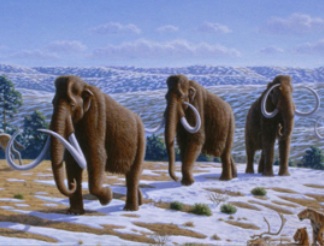At the end of the last ice age, North America was in the midst of an epic thaw. The giant glaciers that had covered nearly all of Canada and the northern United States for millennia were receding fast. Spring was in the air.

Shuffling into oblivion: Did a comet wipe out the great mammals of North America?
PLoS Biology
This was, presumably, good news for all the exotic creatures that populated North America at the time, including the mammoths, mastodons, giant sloths, sabre-tooth cats, dire wolves, and several other large species, collectively known as the Pleistocene megafauna. It was also good news for the Clovis people, a population of Paleolithic hunters who found their way into North America from Siberia, via an ice-free corridor that ran just east of the Rockies. They had plenty of big game to live on, as their kill sites demonstrate.
So what happened?
Just under 13,000 years ago, with everything looking rosy, the climate suddenly took a precipitous swing back toward the deep freeze. Temperature plummeted. At the same time, the big animals disappeared — and so did the Clovis people. Today what we consider to be the native wildlife of North America is just a pale shadow of what once was. A moose is impressive, to be sure, but there should also be mastodon running around in the forests of Appalachia, and curvy-tusked mammoth right alongside those buffalo on the Great Plains.
Theories abound to explain what exactly eliminated these giant species. It’s possible that a sudden release of meltwater into the North Atlantic temporarily shut down the ocean’s circulatory system. Without the Gulf Stream to bring warm water up from lower latitudes the climate would have cooled, forests would have dried out and burned, and large species would have been severely compromised. Add humans to the mix and perhaps excessive hunting was the straw that broke the prehistoric pachyderm’s back.
Or maybe a comet did it.
That’s what one team of researchers is now saying, and they base their conclusion on microscopic diamonds that have turned up all over the Northern Hemisphere in sediments that date back to the extinction of the megafauna. However, critics counter that this scenario is, at best, highly unlikely. Now everyone is looking for new clues to resolve the controversy.
You can read about the current state of this topic in the September issue of Sky & Telescope magazine. And in the latest episode of The Universe in Mind podcast you can hear from researchers on both sides of the debate. It’s a great story — one we certainly haven’t heard the last of yet.
Ivan Semeniuk is host of the podcast The Universe in Mind and a science journalist in residence at the Dunlap Institute for Astronomy and Astrophysics, University of Toronto.
 4
4
Comments
Pete
August 27, 2009 at 6:10 pm
It was a comet.....I was really young at the time. But I remembered it.
You must be logged in to post a comment.
Peter Wilson
August 28, 2009 at 11:53 am
That was so many reincarnations ago, I really can't remember, but comet sounds right.
You must be logged in to post a comment.
Tom M
August 28, 2009 at 8:55 pm
No, no, no, it definitely wasn't a comet. I have solid evidence that it was overhunting, by Sasquatch. Once they killed all the megafauna, they died out too since that's all they really prefered to eat. That's why so few Sasquatch remain to be seen today... Oh, the one I got this story from is an Aquarius, so, he wouldn't lie.
You must be logged in to post a comment.
Tom M
August 28, 2009 at 8:55 pm
No, no, no, it definitely wasn't a comet. I have solid evidence that it was overhunting, by Sasquatch. Once they killed all the megafauna, they died out too since that's all they really prefered to eat. That's why so few Sasquatch remain to be seen today... Oh, the one I got this story from is an Aquarius, so, he wouldn't lie.
You must be logged in to post a comment.
You must be logged in to post a comment.